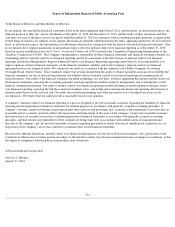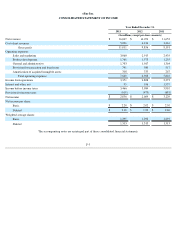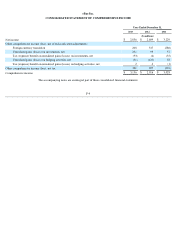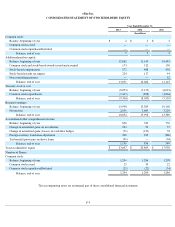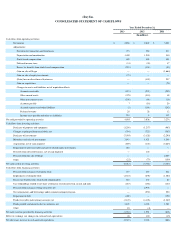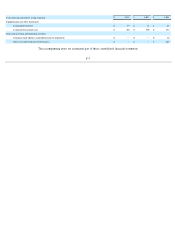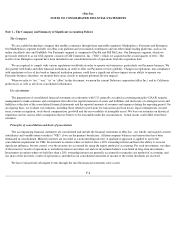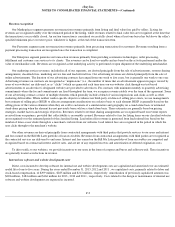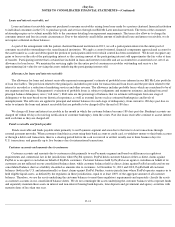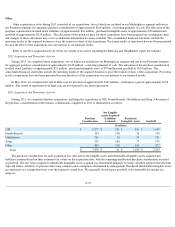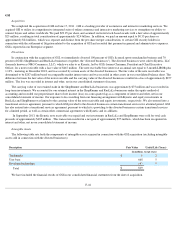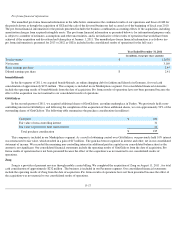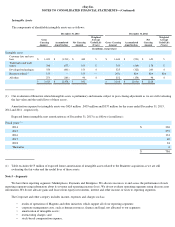eBay 2013 Annual Report Download - page 107
Download and view the complete annual report
Please find page 107 of the 2013 eBay annual report below. You can navigate through the pages in the report by either clicking on the pages listed below, or by using the keyword search tool below to find specific information within the annual report.
eBay Inc.
NOTES TO CONSOLIDATED FINANCIAL STATEMENTS—(Continued)
Advertising expense
We expense the costs of producing advertisements at the time production occurs and expense the cost of communicating advertisements in
the period during which the advertising space or airtime is used, in each case as sales and marketing expense. Internet advertising expenses are
recognized based on the terms of the individual agreements, which are generally over the greater of the ratio of the number of impressions
delivered over the total number of contracted impressions, on a pay-per-click basis, or on a straight-line basis over the term of the contract.
Advertising expense totaled $1.0 billion , $1.1 billion and $977 million for the years ended December 31, 2013, 2012 and 2011 , respectively.
Stock-based compensation
We have equity incentive plans under which we grant equity awards, including stock options, restricted stock units, performance-based
restricted stock units, performance share units and nonvested shares, to our directors, officers and employees. We primarily issue restricted stock
units. We determine compensation expense associated with restricted stock units based on the fair value of our common stock on the date of
grant. We determine compensation expense associated with stock options based on the estimated grant date fair value method using the Black-
Scholes valuation model. We generally recognize compensation expense using a straight-line amortization method over the respective vesting
period for awards that are ultimately expected to vest. Accordingly, stock-based compensation expense for 2013 , 2012 and 2011 has been
reduced for estimated forfeitures. When estimating forfeitures, we consider voluntary termination behaviors as well as trends of actual option
forfeitures. We recognize a benefit from stock-
based compensation in equity to the extent that an incremental tax benefit is realized by following
the ordering provisions of the tax law. In addition, we account for the indirect effects of stock-based compensation on the research tax credit and
the foreign tax credit through our consolidated statement of income.
Provision for transaction losses
We are exposed to losses due to payment card and other payment misuse, as well as non-performance of and credit losses from sellers.
Provisions for these items represent our estimate of actual losses based on our historical experience and actuarial techniques, as well as economic
conditions. Provision for transaction losses includes PayPal's transaction loss expense as well as losses resulting from our customer protection
programs on and off our platforms.
Income taxes
We account for income taxes using an asset and liability approach, which requires the recognition of taxes payable or refundable for the
current year and deferred tax liabilities and assets for the future tax consequences of events that have been recognized in our financial statements
or tax returns. The measurement of current and deferred tax assets and liabilities is based on provisions of enacted tax laws; the effects of future
changes in tax laws or rates are not anticipated. If necessary, the measurement of deferred tax assets is reduced by the amount of any tax benefits
that are not expected to be realized based on available evidence.
We report a liability for unrecognized tax benefits resulting from uncertain tax positions taken or expected to be taken in a tax return. We
recognize interest and penalties, if any, related to unrecognized tax benefits in income tax expense.
Cash and cash equivalents
Cash and cash equivalents are short-term, highly liquid investments with original maturities of three months or less when purchased and
are mainly comprised of bank deposits, certificates of deposit, money market funds and commercial paper.
Allowance for doubtful accounts and authorized credits
We record our allowance for doubtful accounts based upon our assessment of various factors. We consider historical experience, the age of
the accounts receivable balances, credit quality of our customers, current economic conditions and other factors that may affect our customers'
ability to pay. The allowance for doubtful accounts and authorized credits was $106 million and $89 million at December 31, 2013 and 2012 ,
respectively.
F-10


